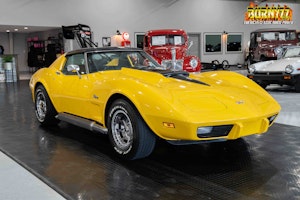Media | Articles
This pale-green 1960 Lotus 19 tasted victory with Graham Hill, Jim Clark, and Innes Ireland
In 1960, Lotus was still a very young company. Founder Colin Chapman was 32 years old, and the first Lotus production car had only just come out in 1952. Team Lotus (the racing arm of the company) started two years after that. At the end of the decade, though, Chapman’s little operation already had a lot to brag about. The Seven was a popular and successful club racer, the streamlined Eleven sports racer had racked up class victories in international endurance racing, and the fiberglass Elite was one of the most sophisticated cars on the road. Not bad at all.
This trim little racer, however, conjures Lotus’ first success in Formula 1, when Stirling Moss drove a privately-entered Lotus 18 to victory in Monaco. The 18 was Lotus’s first mid-engine single seater (and one of the first mid-engine cars anywhere on the grid after Cooper) and Lotus promptly introduced a sports car derivative: the Lotus 19, also known as the “Monte Carlo,” in honor of the Monaco win. A total of 17 examples were built; this is among the most successful. Chassis #953, the last car that Stirling Moss drove as a professional racing driver and a consistent winner from 1961–64 in the hands of other legends like Graham Hill, Jim Clark, Innes Ireland, Masten Gregory, and Olivier Gendebien, will headline the Silverstone Auctions Race Retro sale in the UK on February 21.
To transform the 18 into the 19, Lotus widened the 18’s center section and draped it in attractive, curvy fiberglass body. The chassis is a tubular spaceframe and suspension is double wishbones up front and reversed lower wishbones at the rear. Engines ranged from 1.5 liters to the 2.75-liter Coventry Climax FPF four, although some 19s eventually used American V-8s from Oldsmobile, Buick, Chevrolet, and Ford. The last 19, called the 19B, was in fact specifically designed to take a Ford 289. Gearboxes were either ZFs, Colottis or Lotus’s own five-speed, called the “Queerbox.”
The 19 was a winner right out of the box, breaking the lap record at Silverstone during testing and taking the checkered flag at its very first race in Sweden in 1960. It kept on winning, too, remaining competitive well into the mid-1960s. However, the designs that followed—the Lotus 30 and 40—were both disasters, and Lotus focused (to great success) on Formula 1. The 19, then, is the last of the great Lotus sports racers—not to mention one of the prettiest.
The fourth Lotus 19 built, chassis #953 first sold to the British Racing Partnership (BRP) team, which soon changed its name to UDT-Laystall after a sponsorship deal. The team’s colors, which adorned various Lotus single seaters and even a Ferrari 250 GTO, were a distinctive pale green with a tartan band across the nose. UDT-Laystall ran three Lotus 19s to considerable success in the UK, North America, and the Bahamas, and #953 snagged its first win at Oulton Park in 1961. Olivier Gendebien won his class at Riverside and Laguna Seca later that year. In 1962, #953 won a whopping six races in a row: Oulton Park, Goodwood, Aintree and Silverstone with Innes Ireland, Mosport with Masten Gregory and Snetterton with Graham Hill, and then second at Brands Hatch before another win at Oulton Park with Innes Ireland.
Marketplace
Buy and sell classics with confidence
20200130190527)
20200130190546)
20200130190557)
The next year, the car finished on the podium at Goodwood. Before the race, Stirling Moss, finally recovered from his massive accident there the year before, chose #953 to try out on track and evaluated whether he was ready to go racing again. After the drive he decided he should retire instead, making this the last car he drove as a professional racing driver. It’s important to note, however, that he didn’t actually race this car. He raced and won in other Lotus 19s, but those drives were in the UDT-Laystall team’s other two cars (chassis #950 and #952).
Meanwhile, Innes Ireland notched two more podiums with 953 in 1963 and Tony Maggs finished fourth at Brands Hatch. Then, the team sold the car via a listing in Autosport magazine. The ad called it “Probably the most successful sports car to be seen in the past few seasons”—and its winning days weren’t over. After a few races with its next owner, it sold again in 1964 and Jim Clark won with it at Oulton Park. Chassis #953’s last victory was with owner George Pitt at Aintree.
After a crash at Silverstone in 1965 that damaged the chassis, the car went into the owner’s garage, which caught fire the following year and damaged the car even further. Chassis #953 then sat—for 30 years. Someone bought the remains in 1996 and began a restoration, but the process dragged on until 2012 when the 19 was finally finished in time for a Lotus celebration at Shelsley Walsh, where Stirling Moss signed the engine cover. The current owner then bought it in 2017.
It’s not quite clear how much of 953 had to be replaced during restoration, but the damaged chassis was repaired and its original Colotti gearbox does remain. The engine is a non-original but appropriate 2.5-liter Climax unit, and the gear linkage was fabricated by the restorer.
With a resume that includes 10 wins and seat time from F1 World Champions and Le Mans winners, this is the most significant Lotus sports car to come to auction in recent memory and is certainly a unique opportunity. The two most expensive Lotuses sold at auction are an ex-Graham Hill 1968 49B Grand Prix car that sold in Goodwood in 2014 for £673,500 ($1,147,135 at the time) and a 1964 Type 34 Indy car that sold for $1,150,000 at Quail Lodge in 2017, so we’re eager to see how this pale green sports racer stacks up when it crosses the block.
20200130190518)








20200130190538)
20200130190609)
20200130190618)

